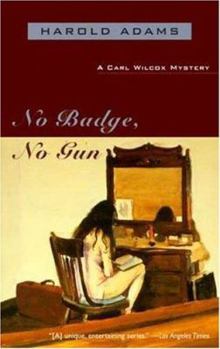Book Overview
Carl Wilcox, a sort of Sam Spade of the Depression-era Prairie, sets out to find the killer of a brilliant teenage girl. This description may be from another edition of this product.
Format:Paperback
Language:English
ISBN:0802775756
ISBN13:9780802775757
Release Date:November 1999
Publisher:Walker Books
Length:202 Pages
Weight:0.85 lbs.
Dimensions:0.6" x 5.0" x 7.7"
Customer Reviews
3 ratings
Strong sense of Depression-era Upper Midwest small-town life
Published by Thriftbooks.com User , 23 years ago
It's a good time for Harold Adams, whose novels about itinerent sign painter ex-cop Carl Wilcox had been languishing, garnering critical raves but little in the way of sales. Walker & Company, a publishing house becoming known for literate, sometimes off-beat mysteries, has released four books so far in trade paperback and published new ones in hardback. This is a series well worth investigating.Wilcox reminds me of every boy's favorite uncle, the one who's a black sheep to the women of the family for not settling down, who stops by when he needs a bed and a few square meals, bringing with him a whiff of sin and a few great stories. He travels the small towns of the Dakotas and Minnesota during the Depression, taking on sign-painting jobs for grocery stores and law offices when they're available, and camping by the side of the road in his modified Model T. When the jobs are few on the ground, he'll take on a murder investigation.In "A Way with Widows," his sister asks him to come to Red Ford, North Dakota, to help clear a neighbor of killing her husband, who was found on the stairs of another woman's house. In "No Badge, No Gun," a minister who has heard of Wilcox's reputation as an investigator asks him to solve the murder of his niece, found dead in the basement of a church. Wilcox's investigating style consists of wandering around town, talking to people, gathering threads of facts and weaving them into a plausible story. He's suspicious, but not cynical. Told about the perfect character of a churchgoing man, he observes, "Nothing in this world raises more doubts in my mind than apparently perfect young men."Yet Wilcox is also a flawed man. He makes mistakes and is perfectly capable of being turned by a pretty widow with something to hide. His attempts at seduction sometimes succeed, but more often fail, which makes sense at a time when a woman's reputation could be affected by who she's seen with. One hopes for better things for Adams and Wilcox, but if it doesn't happen, it won't be the fault of the publisher. Like most of Walker's books, these are beautiful to look at -- details from Edward Hopper's paintings appear on most of them, which is a nice change from the usual blood and skulls that passes for art on most mystery covers -- and the $8.95 price tag is more than reasonable for these absorbing tales of small-town crimes of passion.
Prairie noir sweeps Depression-era Dakotas
Published by Thriftbooks.com User , 25 years ago
For some of us too young to know better, the world of the Depression can seem as foreign a place as Moscow or Outer Mongolia. It was, after all, a half-century ago, before computers, television, the Interstate Highway system and couple of major wars. Which is why following Carl Wilcox, part-time bum, former convict and itinerant sign painter as he travels from town to town in the Dakotas so fascinating. In addition to painting signs and doing what he can to bring body and soul a little closer together, he sometimes investigate cases in small towns like Hope, Jonesville and Greenhill. For the most part, these are pretty quiet stories about small towns where there's not much to do, and where murders are few and far between. Adams's books describe a Depression-era Dakotas of quiet small towns where private reputations and public behavior mattered. His Wilcox is a quiet man, willing to work when he needs money and loaf when he doesn't. His constant pursuit of any semi-willing women would be off-putting were it not realistically depicted (i.e., he doesn't succeed very often). One added bonus can be found in the design of the books, whose covers sport art by Edward Hopper and Thomas Hart Benton. Not your usual mystery book design.
Wilcox remains fresh and fun in this Depression era tale
Published by Thriftbooks.com User , 25 years ago
During the Depression, sign painter Carl Wilcox has earned a reputation throughout the Dakotas for solving murder mysteries, which is why Pastor Bjorn Bjornsen invites him to lunch. Bjorn and his nephew Sven offer Carl $100 to discover who raped and murdered the pastor's niece Gwendolyn in their church basement. Carl begins his inquiries by talking to the cop on the case, Officer Driscoll, who has unofficially given up on the case, but does provide Carl the needed information. Carl follows up with discussions about the victim with her teachers, friends, and family. As he continues to look into the brutal death of a child with no seeming enemies or anyone with a motive to hurt her, Carl begins to wonder if even he can solve this mystery. The fifteenth Wilcox depression era who-done-it keeps the freshness that has constantly made this series one of the best historical mysteries on the market. The story line fits the period, making it seem much more alive than fiction normally produces. However, it is the talent of Harold Adams to brilliantly describe a host of characters as seen through their varying relationships with succinct and abrupt Carl that makes NO BADGE, NO GUN and , for that matter all the Wilcox books, must reading for sub-genre fans.Harriet Klausner




